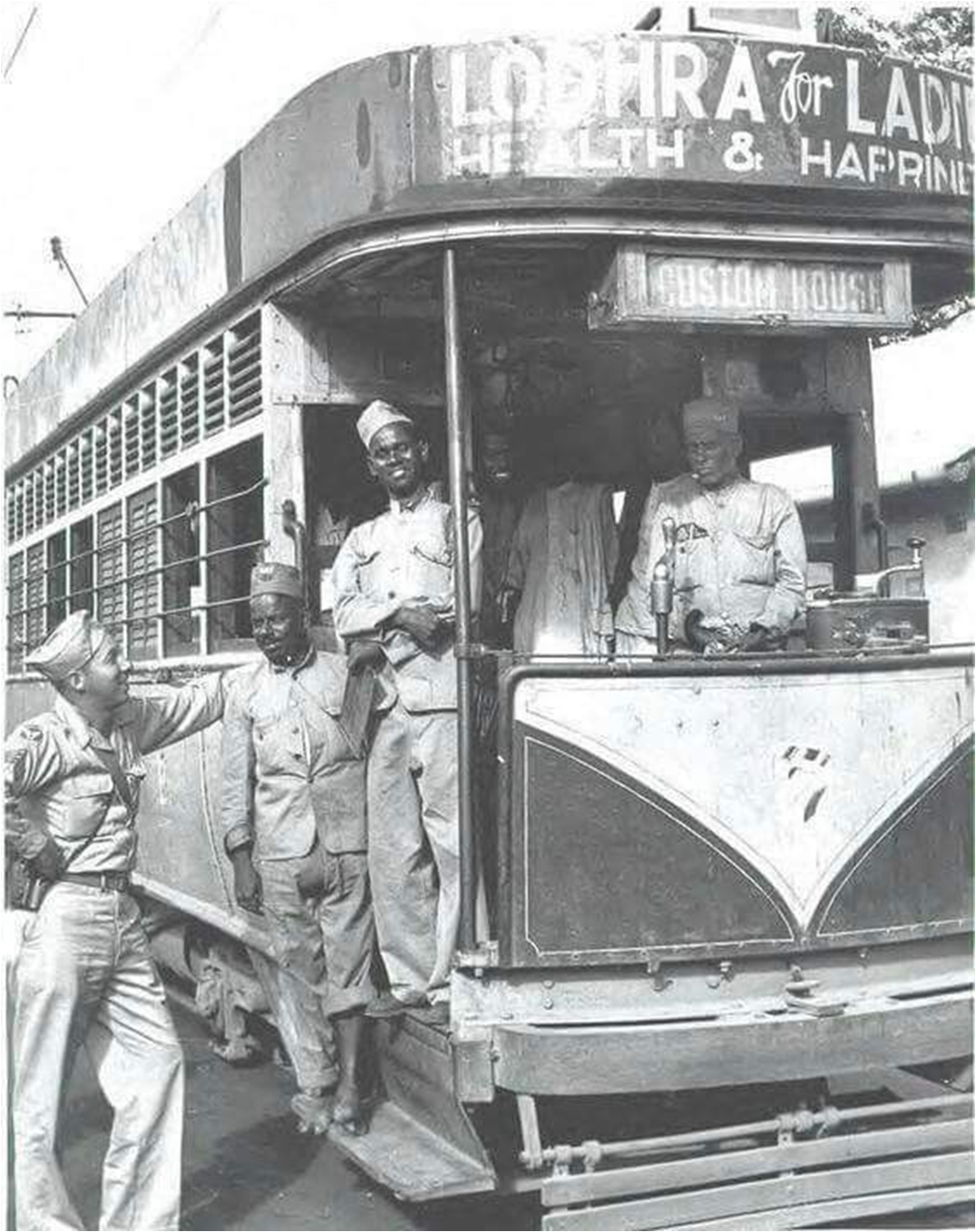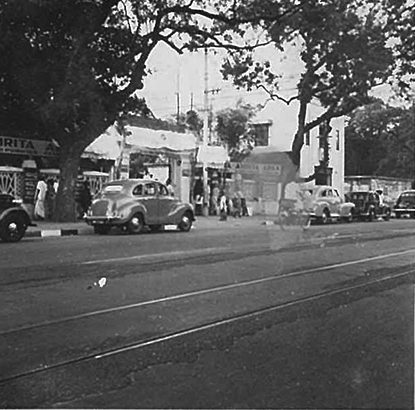Registered with the Registrar of Newspapers for India under R.N.I 53640/91
Vol. XXX No. 2, May 1-15, 2020
The Vanished ‘Gentleman’ of the Road — Remembering the Madras Tram
By K. Balakesari
 The Madras tram
The Madras tram  The tram lines that passed through Westcott Road, Royapettah, June 1951
The tram lines that passed through Westcott Road, Royapettah, June 1951The accompanying photograph of a tram car of the long defunct Madras Tramways Company that wound up its operations in the early nineteen fifties is remarkable for the diverse memories that it evokes of a bygone era. The photograph, so the editor of Madras Musings informs me, is part of what is now known as the Hensley and Bond Collection, at the University of Chicago. It is part of several pictures taken by Glenn S. Hensley and Frank Bond, both US servicemen posted in India during the Second World War. How it came my (or rather my brother Dr.K.Radhakrishnan’s) way is a story for another day. The tram car featured in the photograph is rather special for me and our family as it carries an advertisement for Lodhra, the flagship product of the ayurvedic medicine manufacturing establishment Kesari Kuteeram founded by my grandfather Dr. K.N. Kesari 120 years ago. The ad reads “Lodhra for Ladies’ Health and Happiness”. There were also trams carrying ads for the other medicines such as Amrita and Arka which, along with Lodhra made up what used to be known in those days as Kesari’s Three Gems. In fact, with its speed not exceeding about 20 miles per hour and ambling along the important thoroughfares of the city offering high visibility, the tram was a popular medium for publicity for a variety of products. I can recall Amrutanjan, Raja Snow, and Margo Soap, to name a few.
The photo features the longer version of the tram cars that were in service those days with the sides painted grey and the ends painted red and grey. These larger cars plied on the arterial routes such as Parry’s Corner or Custom House to Mylapore. The shorter version covered the more crowded areas such as Triplicane. The photo appears to be a posed one taken probably at or near a terminal depot considering the relaxed pose of the person seen chatting with the staff on the car and the proximity of a structure visible in the background. The three staff seem immensely pleased to pose with a white sahib.
The photo also shows some typical features of the Madras tram. In the front can be seen the control stand with the regulator handle which the driver moved in a horizontal circular arc to control the speed of the tram. The thin rod visible at the top rear background carried the cable transmitting the power from the overhead contact wire to the electric traction motors underneath the car. Each car had two such rods, one for each direction. Unlike the pantograph on the electric trains with a broad metal strip making contact with the overhead contact wire, in trams, a pulley at the end of the rod was the point of contact with the overhead wire. The grooved pulley rolled along the wire as the tram moved. The upward pressure exerted by the spring-loaded rod guided the pulley along the wire. The rod with the pulley swivelled at rakish angles as the tram negotiated sharp curves on the roads. At night, the sparks that emanated from the pulley as it went over junction points on the contact wire were a typical sight, and they were accompanied by a crackling sound.
The electric tram was a popular and affordable means of public transport. Despite its noisy presence, with the typical whirring sound of the accelerating motors, the tram exuded a feeling of friendliness and tranquillity in contrast to its more unruly and polluting fellow traveller of the road, the transport bus. After all, with its limited speed and fixed paths, pedestrians had no fear of getting run over and could boldly cross the road in the face of an approaching tram, unlike a transport bus which even in those days was a potential killer. I have never heard of a tram running over a pedestrian or causing a serious accident. The tram never overtook another vehicle. It remained content to move on its “predestined grooves”. And since it generated enough noise in motion, it announced its presence by clanging bells instead of honking a horn. Perhaps the most passenger-friendly feature of the tram was the low floor height that made it easily accessible to the old and the young, man woman or child. Truly, a gentleman on Madras roads! By the time the service was eventually closed in April 1953, the network had extended to about 26 km and carried 125,000 passengers every day.
The second photograph, which is from our family album, shows the two pairs of tram lines that passed through Westcott Road, Royapettah, in front of our house. These lines linked Mylapore in the south with Custom House/Parry’s Corner in the north, passing through Mount Road. There is no doubt about the date of this photograph. It was taken in June 1951, during the Golden Jubilee celebrations of Kesari Kuteeram (founded in 1900). The building visible in the rear was the front portion of the northern annexe of the old Kesari Kuteeram complex which temporarily housed the Madras Music Academy during the early forties. And behind that (not visible) in the adjoining compound was the men’s hostel of the Meston (teacher’s) Training College, where today the commercial complex Bhattad Tower (the current editorial office of Madras Musings) stands. The ground floor of the hostel was the residence of the principal of the college. Another interesting fact – the neem tree visible in the foreground to the left of the parked car outside the gate still stands, about the only remnant of those days!
Trams have inspired limericks, the five-line nonsense verse. The one below is of 1905 vintage:
There was a young man who said “Damn!
I perceive with regret that I am
But a creature that moves
In predestinate grooves
I’m not even a bus, I’m a tram.”
Several years later someone penned a rejoinder which went like this:
Young man you should stay your complaint,
For the grooves that you call a constraint
Are there to contrive
That you learn to survive;
Trams arrive, buses may or they mayn’t.”
So the slow-moving trams also conveyed a profound message!


In my teens I used to travel Free in Tram being Lodhra Paiyan!Getting in/out of moving Tram 5mph. was great fun